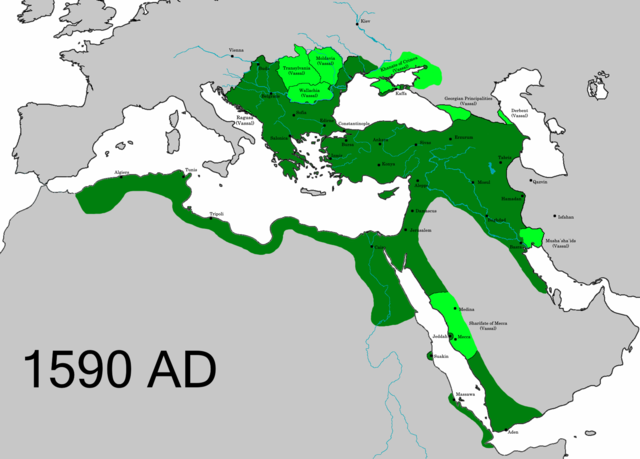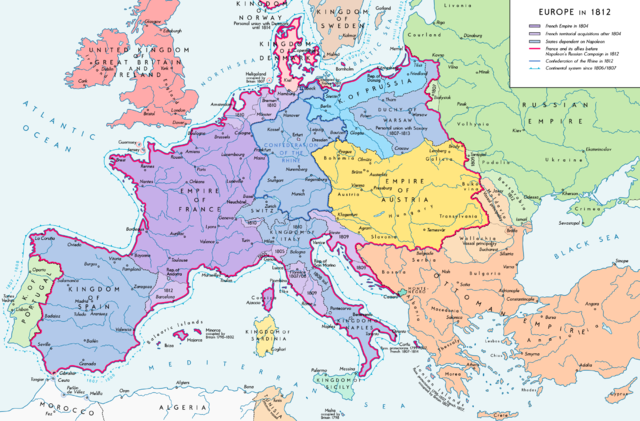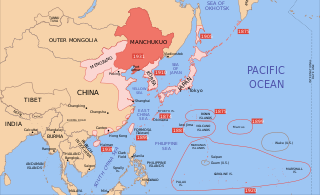In the field of international relations, a client state, is a state that is economically, politically, and militarily subordinated to a more powerful controlling state.[1] Alternative terms[according to whom?] for a client state are satellite state, associated state, and dominion, condominium, self-governing colony, and neo-colony, protectorate, vassal state, puppet state, and tributary state.
Controlling states in history
Persia, Greece, Ancient China and Rome
Ancient states such as Persia and Parthia, Greek city-states, Ancient China and Ancient Rome sometimes created client states by making the leaders of that state subservient, having to provide tribute and soldiers. Classical Athens, for example, forced weaker states into the Delian League and in some cases imposed democratic governments on them. Later, Philip II of Macedon similarly imposed the League of Corinth. One of the most prolific users of client states was Republican Rome[2][3] which, instead of conquering and then absorbing into an empire, chose to make client states out of those it defeated (e.g. Demetrius of Pharos), a policy which was continued up until the 1st century BCE when it became the Roman Empire. Sometimes the client was not a former enemy but a pretender whom Rome helped, Herod the Great being a well-known example. The use of client states continued through the Middle Ages as the feudal system began to take hold.[citation needed]
Ottoman Empire

The number of tributary or vassal states varied over time but most notable were the Khanate of Crimea, Wallachia, Moldavia, Transylvania, the Sharifate of Mecca, and the Sultanate of Aceh.[citation needed]
19th and 20th centuries
This section needs additional citations for verification. (July 2014) |
Russian Empire
Austria-Hungary tried to make Serbia a client state in order to form a Christian opposition to the Ottoman Empire, but after the 1903 May Coup, Serbia came under the influence of Russia, which was forming a pan-Eastern Orthodox opposition to the Latin Christianity represented by the Austro-Hungarian Empire. In 1914, Russia repeatedly warned Austria-Hungary against attacking Serbia. When it did attack, Russia mobilised its army.[4][5][6] Russia also wanted Bulgaria[7] and Montenegro[8] as client states.
At the time, Great Britain and Austria-Hungary both considered Serbia as a client state controlled by Russia.[9]
First French Empire

During the Revolutionary and Napoleonic eras (1789–1815), France conquered most of western Europe and established several client states.
At first, during the French Revolutionary Wars, these states were erected as "Républiques soeurs" ("sister republics"). They were established in Italy (the Cisalpine Republic in Northern Italy and the Parthenopean Republic in Southern Italy), Greece (Îles Ioniennes), Switzerland (the Helvetic Republic and the Rhodanic Republic), and Belgium and the Netherlands (Batavian Republic).
During the First French Empire, while Napoleon I and the French Army occupied much of Europe, such states changed, and several new states were formed. The Italian republics were transformed into the Kingdom of Italy under Napoleon's direct rule in the north, and the Kingdom of Naples in the south, first under Joseph Bonaparte and later under Marshal Joachim Murat. A third state was created in the Italian Peninsula, the Kingdom of Etruria. The Batavian Republic was replaced by the Kingdom of Holland, ruled by Napoleon's third brother, Louis Bonaparte.
A total of 35 German states, all of them allies of France, seceded from the Holy Roman Empire to create the Confederation of the Rhine, a client state created to provide a buffer between France and its two largest enemies to the east, Prussia and Austria. Two of those states were Napoleonic creations: the Kingdom of Westphalia, which was controlled by Jérôme Bonaparte, the Emperor's youngest brother; and the Grand Duchy of Würzburg as was Poland, then the Duchy of Warsaw.
During the French invasion of the Iberian Peninsula, Napoleon attempted to subjugate Portugal and Spain into a client Kingdom of Spain, but the French were eventually driven out of Iberia in a costly war.
France after decolonisation
In the 20th century, France exercised a sphere of influence, or Françafrique over its former African colonies,[10][11] and to some degree former Belgian colonies in Africa (which were also French-speaking). The term is sometimes used pejoratively, to characterise the relationship with France as neocolonial. The former colonies provide oil and minerals important to the French economy, and in some, French companies have commercial interests.
British Empire

The Indian princely states were nominally sovereign entities in the British Empire and in 1947, were given a choice to either accede to independent India or Pakistan or get independence (the Nizam of Hyderabad did opt for independence but his kingdom was annexed by Indian forces in 1948). Egyptian independence in 1922 ended its brief status as a British protectorate and Iraq was made a kingdom in 1932. But in both cases, the economic and military reality did not amount to full independence, but a status where the local rulers were British clients. Other instances include Africa (e.g. Northern Nigeria under Lord Lugard), and the Unfederated Malay States; the policy of indirect rule.
Germany
World War I
 Kingdom of Poland[12] (1917–1918)
Kingdom of Poland[12] (1917–1918) Kingdom of Lithuania (1918)
Kingdom of Lithuania (1918) Ukrainian State[13] (1918)
Ukrainian State[13] (1918)- Duchy of Courland and Semigallia[14] (1918)
 Democratic Republic of Georgia[15] (1918)
Democratic Republic of Georgia[15] (1918)
World War II
 Vichy France (1940–1944)
Vichy France (1940–1944) Independent State of Croatia (1941–1945)
Independent State of Croatia (1941–1945) Slovak Republic (1939–1945)
Slovak Republic (1939–1945) Albanian Kingdom (1943–1944)
Albanian Kingdom (1943–1944)
United States

The term has also been applied to states which are extremely economically dependent on a more powerful nation. The three Pacific Ocean countries associated with the United States under the Compact of Free Association (the Federated States of Micronesia, the Marshall Islands, and Palau) have been called client states.[16][17][18]
 China (1945–1949) →
China (1945–1949) →  Taiwan (1949–1979)
Taiwan (1949–1979) Khmer Republic (1970–1975)
Khmer Republic (1970–1975) Philippines (1965–1986)
Philippines (1965–1986) South Korea (1948–1953)
South Korea (1948–1953) South Vietnam (1955–1975)
South Vietnam (1955–1975)
Imperial Japan

In the late 19th century, the Empire of Japan gradually reduced Joseon Korea's status to that of a client state. In the early 20th century, this was converted to direct rule. Manchukuo, in contrast, remained a puppet state throughout World War II.
 Azad Hind (1943–1945)
Azad Hind (1943–1945) State of Burma (1943–1945)
State of Burma (1943–1945) Kingdom of Kampuchea (1945)
Kingdom of Kampuchea (1945)- China (East Hebei Autonomous Government and North Shanxi Autonomous Government)[19]
 Great Way Government (1937–1938)
Great Way Government (1937–1938) Provisional Government of the Republic of China (1937–1940)
Provisional Government of the Republic of China (1937–1940) Reorganised National Government of the Republic of China (1940–1945)
Reorganised National Government of the Republic of China (1940–1945)
 Joseon (After the First Sino-Japanese War)[20]
Joseon (After the First Sino-Japanese War)[20] Korean Empire[21][22][unreliable source] (1905–1910)
Korean Empire[21][22][unreliable source] (1905–1910) Kingdom of Luang Phrabang (1945)
Kingdom of Luang Phrabang (1945) Manchukuo (1932–1945)
Manchukuo (1932–1945) Mengjiang (1939–1945)
Mengjiang (1939–1945) Second Philippine Republic (1943–1945)
Second Philippine Republic (1943–1945) Empire of Vietnam (1945)
Empire of Vietnam (1945)
Soviet Union
Soviet proxy, "satellite", or client states included much of the Warsaw Pact member states whose policies were heavily influenced by Soviet military power and economic aid. Other nations with Marxist–Leninist governments were routinely criticised as being Soviet proxies as well, among them Cuba following the Cuban Revolution, the Chinese Soviet Republic, North Korea,[23] North Vietnam, South Yemen, the People's Republic of Angola, the People's Republic of Mozambique, and the Democratic Republic of Afghanistan. Within the Soviet Union itself, the Ukrainian SSR and the Byelorussian SSR, had seats at the United Nations, but were actually proper Soviet territory.
See also
References
Wikiwand in your browser!
Seamless Wikipedia browsing. On steroids.
Every time you click a link to Wikipedia, Wiktionary or Wikiquote in your browser's search results, it will show the modern Wikiwand interface.
Wikiwand extension is a five stars, simple, with minimum permission required to keep your browsing private, safe and transparent.